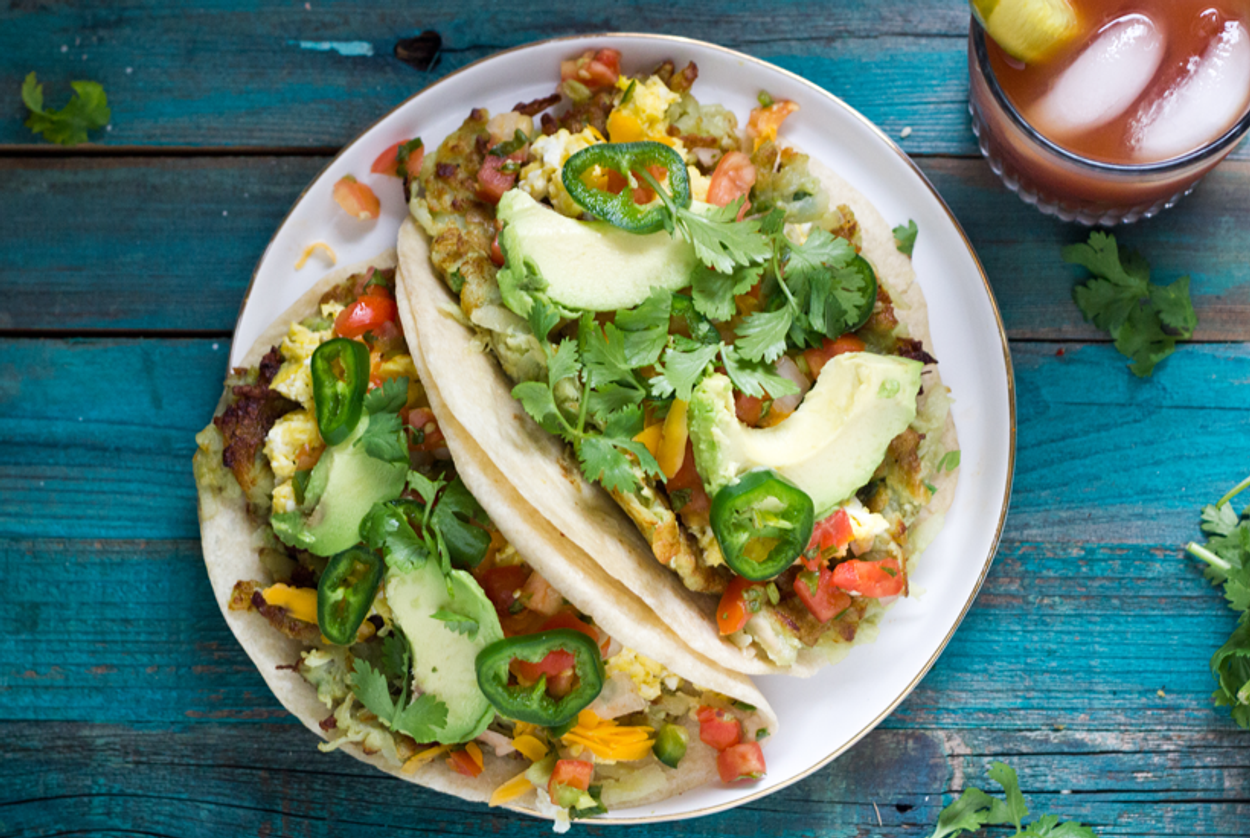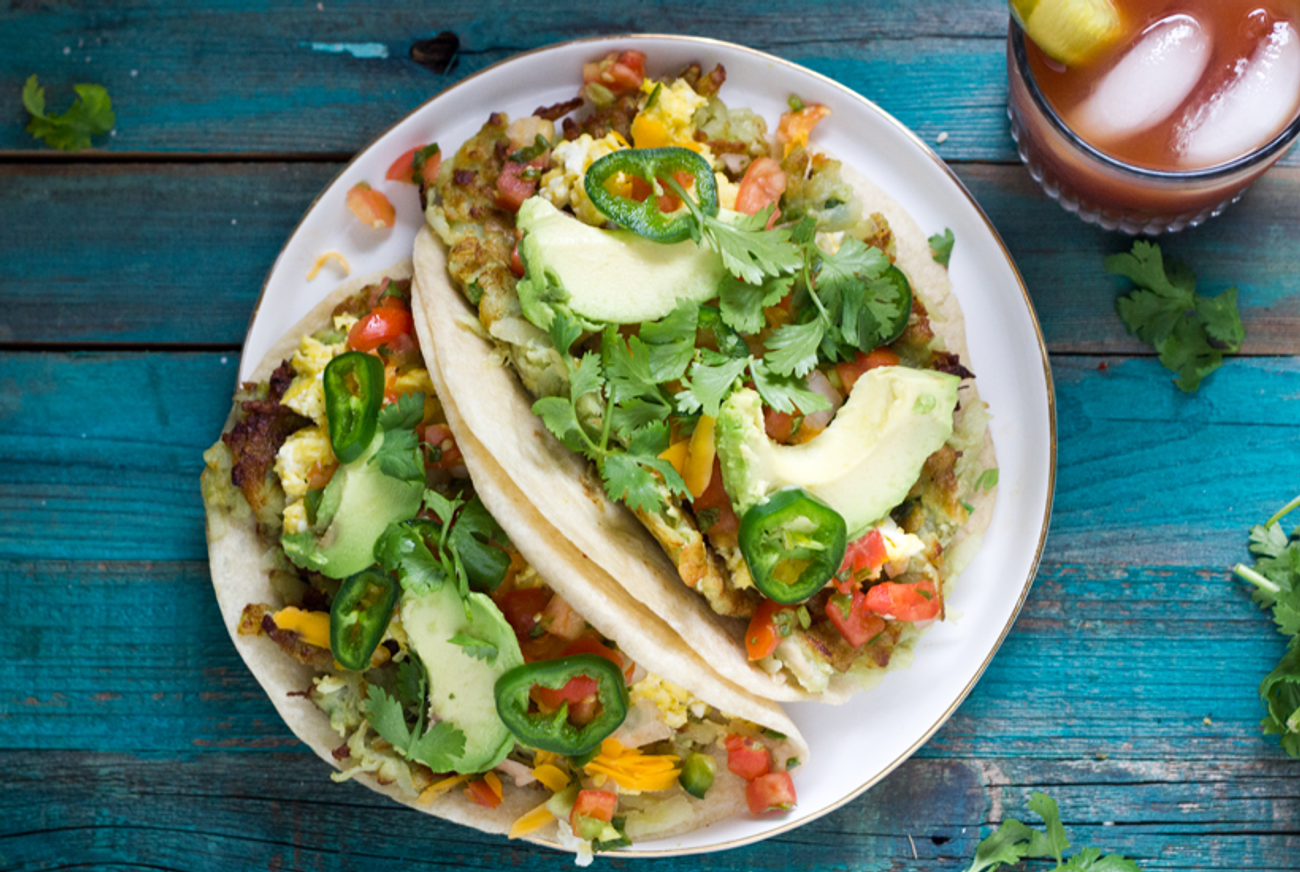Give Your Latkes a Taste of Texas
Hold the applesauce and skip the sour cream. Grab some pico de gallo and wrap your Hanukkah treats in a breakfast taco instead.




When I was in first grade, my mother visited my class one blustery December morning to teach the kids about Hanukkah. (Nobody else was going to do it; there was exactly one other Jewish student in my smalltown Connecticut school—my brother.) She told the class about the menorah and the miracle of the oil. And she brought lots of chocolate gelt, because if candy couldn’t convince a bunch of 6-year-olds that being Jewish was cool, nothing would.
Then we moved across the state to West Hartford, where being Jewish wasn’t anything unusual: Schools were closed for the High Holidays, and my teachers were Mrs. Schwartz and Mr. Klein. I witnessed nearly 50 of my classmates become bar or bat mitzvah in one year. While it was nice not having to explain to my peers every Passover what matzo was, I came to miss the sense of being different.
This became a pattern as I grew up. Sometimes I would be a part of the crowd in a mostly Jewish area (such as Jewish overnight camp), other times I was the oddball in a mostly non-Jewish place. But one thing has remained a constant for me: connecting to Judaism through food. When I was little, and my friends were playing with their GameBoys or their Polly Pockets, I was making blintzes with my Bubbe. All these years later, food is still how I connect to my heritage, and how I share Jewish culture with the non-Jews around me, especially around holidays.
When I went to college at Emory in Atlanta, I didn’t just stick with my own kind. I moved in with a pair of Catholic roommates from Nashville (and one Jew from Westchester), and the four of us did the South right: Nascar, county fairs, country music. But I didn’t lose my Jewish identity. On the contrary, now that I wasn’t surrounded by Jews anymore, I wanted to share my heritage, in my own quirky way. I started hosting annual nontraditional Seders for my mostly gentile friends: I tweaked the Haggadah to include some inside jokes, and we had Easter candy and kegs for the non-practicing. But the message, not to mention the Manischewitz and matzo-ball soup, was there.
After I graduated, I drove to New York City, a city I visited often as a child. My great-uncle lived on the Lower East Side and would take us to Kossar’s for bialys, Guss’ for pickles, and Katz’s for pastrami sandwiches as large as my face. Again, I was surrounded by Jews but kind of lost my religion. When I was among my people, it didn’t feel as urgent to keep tradition.
After five years in New York, I moved to Austin. Less than a month later, I had a new job, my first car in years, and an apartment the size of a penthouse, for less than price of a walk-up in Greenpoint, Brooklyn (before it was cool). My new co-workers, with their southern hospitality, took me to breakfast to give me the rundown on office politics. We walked into the nearest breakfast taco joint. (Typically a filled tortilla of scrambled eggs, cheese, and greasy fried potatoes—or bacon—topped with pico de gallo and avocado if you’re lucky, jalapeño if you’re brave, the breakfast taco is an Austin staple, made even more popular by being an excellent vehicle for curing the previous night’s happy-hour indulgences.) I joyfully exclaimed that this would be my first time trying the Tex-Mex treat. When my coworkers heard I was a breakfast taco virgin, you would think I had said I had never tried pizza. Or, for comparison, a bagel. “But what did you eat for breakfast in New York?” they asked.
My first breakfast taco did not disappoint and started a long love affair with the simple and yet also complex nosh. The book Austin Breakfast Tacos: The Most Important Taco of the Day details how Mexican settlers in Austin in the 1870s brought traditional tamales and other delicacies when they immigrated and opened food stands downtown (the first food trucks, if you will). Though no one is quite sure who popularized the breakfast variety, it was bound to happen.
While my new job paid the bills, it didn’t inspire me. I thought back to my cooking days with Bubbe and decided to start a blog about Jewish food, called What Jew Wanna Eat, with the tagline “This ain’t yo Bubbe’s blog.” (When I showed my blog to my coworker, she asked, “What’s a Bubbe?” Once again, I found myself the lone Jew.) I went to culinary school and became a full-time chef and blogger.
Here in Austin, the recipes I create often combine local influences with Jewish traditions, from Hatch chile hummus, to Tex Mex sabich, to brisket braised in Shiner beer. I love to combine the heat of Texas cooking with the recipes of my youth. As Anthony Bourdain once said: “Only Texans and Jews understand brisket.”
That’s how I ended up making one of my favorite traditional Hanukkah recipes, latkes, into a dish Tex Mex that speaks to the non-Jews in my current Texas home. I mashed up the best breakfast taco fixins with my favorite fried treat to make a uniquely Texan dish for the Festival of Lights: avocado latkes breakfast tacos (recipe here). The result is spicy, cheesy, and has the perfect amount of grease to fuel you for eight days of dreidel games.
Amy Kritzer is a food writer and recipe developer in Austin, Texas. She blogs at What Jew Wanna Eat, and her work has been featured on Bon Appetit, Daily Candy, and the Today show blog.